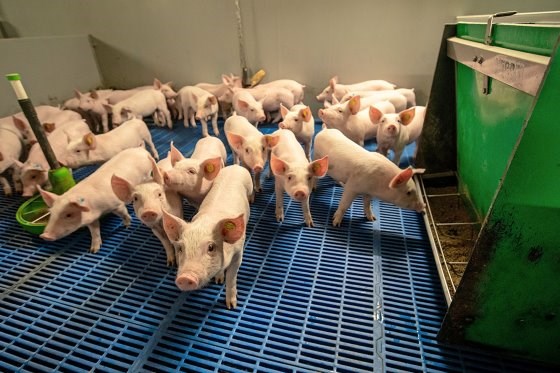Porcine Reproductive and Respiratory Syndrome (PRRS) virus is one of the most important pathogens the swine industry is currently dealing with. The impact of the virus is not only caused by the disease itself, but is also due to increased prevalence of secondary infections. On “problem” farms, where farm-management and biosecurity measures cannot fully control the disease, an immunomodulation strategy could help control PRRS.
PRRS virus (PRRSv) belongs to the family of arteriviruses and is a small, enveloped, positive single-stranded RNA virus. Clinical signs of PRRS are highly variable. Substantial increases in abortions, stillbirths, pre-weaning mortality and respiratory diseases in weaners and growers are commonly reported clinical signs of PRRS.
The susceptibility of PRRSv-infected pigs to secondary bacterial or viral infections increases dramatically. For instance, concurrent infections with Streptococcus suis are frequently reported. The prevalence of secondary infections together with the direct losses caused by PRRSv are the reason for the major economic impact of this viral syndrome.
One of the main target cells for PRRSv replication are porcine alveolar macrophages (PAMs). These cells serve as the first line of defence against inhaled microbial particles by means of phagocytosis, antigen presentation and production of cytokines. These basic functions are directly impaired when PRRSv replicates in PAMs.
 |
| Glycerides of lauric acid may be a tool for controlling the risk of secondary infections in PRRSv-positive pigs. Photo: Bert Jansen |
Imbalance between cytokines
More specifically, the production of pro-inflammatory cytokines has shown to be limited in PRRSv-infected animals. The absence of sufficient amounts of pro-inflammatory cytokines seems to allow PRRSv to escape from the host immune response. Hence, the immune system is not activated and viral clearance is not initiated, allowing PRRSv
to multiply easily inside the host. The immunosuppressive effect of PRRSv may also contribute to the increased risk of secondary infections.
Apart from the insufficient response of the innate immune system upon PRRSv infection and the creation of an imbalance between pro- and anti-inflammatory cytokines, there is also evidence that neutralising antibodies and virus-specific interferon-gamma (IFN-γ) responses are delayed. Interferon-gamma is involved in the inhibition of PRRSv replication but is downregulated in PRRSv-infected animals. Together with an upregulation of interleukin-10 (IL-10), this might cause an increase of CD163 in macrophages, which is a component of a complex of receptors required for PRRSv entry. An increase of CD163 actually promotes PRRSv entry and replication. As PRRSv is susceptible to the direct antiviral effect of IFN-γ, it seems an interesting target for immunomodulation strategies to overcome PRRS.
Modulating the inflammatory response
Lately, alpha-monolaurin has been gaining more attention because of its ability to modulate the inflammatory response. Most research presents the reduction of pro-inflammatory cytokines. With respect to PRRSv, downregulation of IL-10 is desired. On the other hand, IFN-γ should be upregulated
during PRRSv infection.
Interestingly, Framelco and Belgian research facility Poulpharm discovered a significant increase of IFN-γ in broilers vaccinated against infectious bronchitis (IB) receiving FRA C12 Dry, a product based on glycerides of lauric acid, including alpha-monolaurin. Moreover, a significant increase in
anti-IBV antibody titres was observed in broilers receiving the product compared to the control group. These results encouraged Framelco to conduct more research into the glyceride product and its effect on PRRSv.
At a farm suffering from a severe PRRSv outbreak in Belgium, the effects of the glyceride product were studied. Firstly, one group of sows received regular feed and served as a control group. The second group of sows received the glyceride product before farrowing and during lactation. The weaned piglets also received the product.
In general, the farmer was quite satisfied with the improvements obtained in the group receiving the glycerides of C12 compared to the control group. More specifically, pre-weaning mortality was reduced by 29% in the treatment group. The number of weaned piglets in the treatment group increased by 2.2 piglets per sow, an increase of 19.5%.
Interestingly, weaned piglets in the control group received more individual injections against locomotor problems compared to the treatment group (3.2% versus 1.9% of the total amount of weaned piglets). Based on historical data the causative agent of these locomotor problems was most likely S. suis. Hence, glycerides of C12 seemed to have suppressed the susceptibility to secondary infections with S. suis.
Figure 1 – Percentage of PRRSv positive pens atseven and 37 days after weaning.
Glyceride and PRRSv shedding
To study the effect of the glyceride product on PRRSv shedding, a Poulpharm research team collected oral fluids from weaned piglets. At seven and 37 days after weaning, ten pens were randomly selected and provided with chewing ropes. Piglets were allowed to chew the ropes for 45 minutes, after which oral fluids were collected for analysis (Figure 1). The team analysed oral fluids by an RT-qPCR-test with a cut-off Ct-value of 42.
Values of 42 and higher were reported as negative, whereas values below 42 reflected a positive result, with lower values indicating a higher PRRSv concentration. At seven days after weaning, 20% of the pens in the control group tested positive for PRRSv, whereas in the treatment group this was 10%. At 37 days after weaning, 70% of the pens in the control group tested positive and only 20% in the treatment group. Based on these results, it seemed that FRA C12 Dry reduced PRRSv shedding in weaned piglets.
To understand the mode of action of glycerides of C12 against PRRSv better, an in vitro test is currently being executed. The aim of this trial is to investigate the possible direct antiviral effect of glycerides of lauric acids against PRRSv and its ability to modulate the production of several cytokines in PRRSv-infected cells.
Although the mode of action is currently not yet fully understood, glycerides of lauric acid seem to be an interesting and promising tool assisting directly and/or indirectly in the viral clearance of PRRSv and in controlling the risk of secondary infections in PRRSv-positive pigs.
References are available on request.
https://www.pigprogress.net/